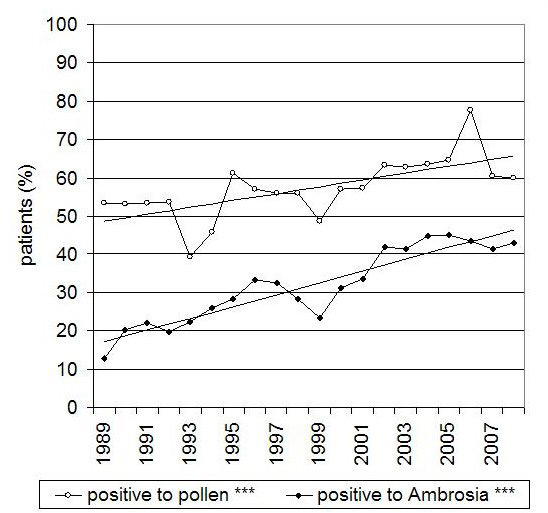
Figure 1
Increase of sensitisation among patients in Legnano. The significance of the trends was calculated using the Mann-Kendall trend test: p <0.001***.
DOI: https://doi.org/10.4414/smw.2011.13253
A 20-year study (1989–2008) in Legnano, northern Italy
Over the last decades, an increased prevalence of allergy to Ambrosia artemisiifolia pollen (short ragweed, henceforth called Ambrosia) has been assessed in Europe, especially in Hungary, Austria, France (Rhône region), northern Italy and a few other countries [1–9]. It is well known from North America that Ambrosia is one of the strongest sensitising pollen species and produces major hay fever symptoms, mainly asthma, during its pollination period in late summer and autumn [10]. In Austria, it has been demonstrated that there is a high correlation between increasing pollen counts of Ambrosia and sensitisation rates [11]. As the Ambrosia plants continue to spread throughout central Europe, data are needed to analyse the long-term consequences of the increasing Ambrosia pollen concentration. It has been postulated that a concentration as low as 1–3 pollen/m3 in the air can lead to allergic symptoms in some previously sensitised patients [12], whereas a concentration between 10 and 20 pollen/m3 frequently causes symptoms in sensitised patients [13]. Consequently, in Switzerland a threshold of 11 Ambrosia pollen/m3 is regarded as a high pollen load [14]. In the region north-west of Milan, where Legnano is situated, Ambrosia started to colonise the area in the 1930s and 1940s, and has become more and more abundant since the 1980s [15]. In 2005, 14% of the population near Milan already suffered from Ambrosia allergy [16]. Due to the wide spreading of Ambrosia in Italy [17, 18], the sensitisation to this pollen has also attracted considerable attention in the southern part of Switzerland (Ticino), close to northern Italy (Lombardia) [19–22]. In fact, a large proportion of the Ambrosia pollen registered in the south of Switzerland in Ticino is considered to originate from Italy [23, 24]. Whereas Geneva showed a significant increase in pollen load from 1979–2001, correlated to the increased pollen concentration in the Lyon region in France [21, 25], for Ticino such an increase was not observed [23, 24].
The aim of this study was to investigate the sensitisation rates to Ambrosia pollen and the prevalence of late summer rhinitis and asthma in Legnano near Milan; a region known for its high Ambrosia pollen concentration.
The development of sensitisation and allergy rates over 20 years together with the recorded pollen data can be useful in creating a possible scenario for other European regions experiencing an increasing abundance of Ambrosia. To estimate the risk of an increase of Ambrosia sensitisation in southern Switzerland, a neighbouring region, pollen data from Lugano are included in this study to provide a comparison with that of Legnano.
All patients, aged more than 14, who attended the “Ambulatorio di Allergologia dell’Ospedale di Legnano” with respiratory symptoms for the first time in the years 1989–2008 were considered for inclusion in the study.
All patients with a skin prick test (SPT) positive to at least one pollen species were interviewed about their clinical symptoms (rhinitis, asthma), the time of their symptoms appearance, particularly in regard to the onset in late summer (August to September), and their age at the time of the first manifestation of the pollen allergy.
Skin prick tests (SPT) with commercial, standardised extracts (most Alyostal, Stallergènes, seldom Soluprick ALK-Abelló) from grass mix, tree mix 1 (birch, alder and hazel), tree mix 2 (beech, oak, plane), cypress, mugwort (Artemisia), ragweed (Ambrosia artemisiifolia), pellitory-on-the-wall (Parietaria), house dust mites, cat and dog epithelia and mould (Alternaria, Cladosporium) were performed on the flexor forearm with a standardised prick needle. Histamine dihydrochloride (10 mg/ml) was used as a positive control, and the glycerol-containing diluent was used as a negative control. Reactions were recorded after 15 minutes. Wheals with a diameter of at least 3 mm in the presence of a negative control were considered positive. In twenty patients, SPTs for Ambrosia were undertaken simultaneously with the extracts of Stallergènes and of ALK-Abelló. The results were similar: none were positive or negative to only one extract.
Daily pollen concentrations have been measured in Legnano since 1995 with a Hirst type pollen trap by the Azienda Sanitaria Locale (ASL) della Provincia di Milano. This pollen monitoring station is connected to the Italian Network Monitoring on Aerobiology (R.I.M.A.®). In Lugano, the measurement of daily pollen concentrations started in 1985 and continued, after a break of two years, in 1991. In Lugano, the pollen concentration is measured by MeteoSwiss also with a Hirst type trap. The pollen trap in Lugano is part of the national pollen monitoring network in Switzerland. The pollen counts were performed according to international standard methods [26].
The significance of the calculated trends was estimated using the Mann-Kendall trend test [27, 28]. For this test neither normal distribution nor linearity of the trend is required. The sum of the signs of all possible differences are used to calculate the test statistic which is approximately standard normally-distributed. Hence this test assesses the increase or decrease of the data elements in the time series. The actual calculation of the significance of the trends was done using the Kendall package which is implemented in the statistical software language R [29].
During the 20 years of the study, clear changes became evident among the patients attending the allergy unit in Legnano for the first time. The number of patients with a positive SPT to Ambrosia increased strongly, starting with 134 patients in 1989 and rising to about 500 patients during the last 8 years of the study (table 1). Also, the yearly number of patients SPT positive to pollen increased significantly but more slowly. Thus the percentage of Ambrosia positive patients among the pollen positive patients was 24% at the beginning and had reached more than 70% after 20 years. As the total number of patients varied over time – with a slightly growing trend – the increase of sensitisation is shown in figure 1 as a percentage of the patients. The patients who were SPT positive to pollen had an augmentation from about 50% to 60%, whereas the prevalence of positive Ambrosia SPT among the patients started with 13% and reached about 45% by the end of the study period.

Figure 1
Increase of sensitisation among patients in Legnano. The significance of the trends was calculated using the Mann-Kendall trend test: p <0.001***.
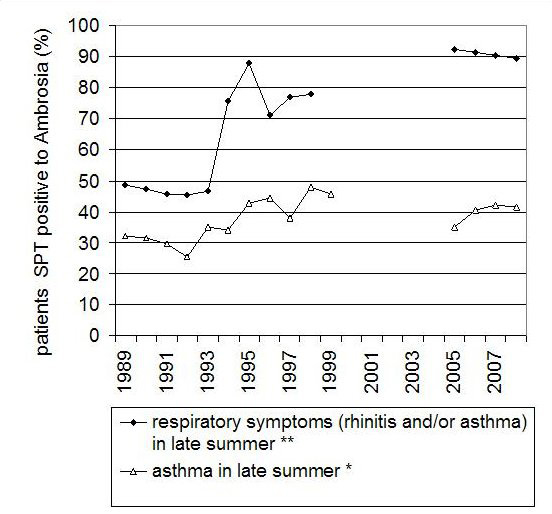
Figure 2
Increase of Ambrosia allergy among Ambrosia SPT positive patients in Legnano. The significance of the trends was calculated using the Mann-Kendall trend test: p <0.05*; p <0.01**.
Also the percentage of Ambrosia SPT positive patients with respiratory symptoms during late summer increased markedly from almost 50% in the years 1989–1993, to 75% in the years 1994–1998, and to more than 90% in the years 2005–2008 (fig. 2). In contrast the incidence of asthma among the Ambrosia SPT positive patients increased only slightly from 30% to more than 40% (fig. 2).
The Ambrosia allergy starts with the typical symptoms of rhinoconjunctivitis and partly with asthma at the end of the first week of August, peaks in intensity at the end of August until the middle of September, and decreases progressively until the second week of October. The rhinitis symptoms are characterised by a marked nasal obstruction, especially at night, and are not seldom complicated at the end of the pollen season by a sinusitis.
In table 2, the sensitisation to Ambrosia or grass pollen is shown according to the patient’s age at the time of its appearance for the years 1999 and 2006. In 1999, 13.7% of the patients with a sensitisation to Ambrosia pollen were older than 50. In 2006, the percentage of this age group increased significantly to 30.4%, whereas the percentage of grass pollen sensitised patients older than 50 remained stable at almost the same level (9.3% in 1999 and 9.5% in 2006). The percentage of the Ambrosia sensitised patients over 60 years old was smaller but, nevertheless, there was an increase from 5.8% in 1999 to 9.5% in 2006, whereas the percentage of grass pollen sensitised patients in 1999 was only 3.5%, and 4.1% in 2006.
The seasonal pollen index (SPI = the sum of daily pollen concentrations from July to October) in Legnano varied between 2600 and 7100 without a clear trend (fig. 3). The lowest SPI was registered in 1995, the first year of measurement. In Lugano, the SPI was on average 16 times lower, varying between 100 and 900, however a large amount of the registered pollen had most likely come from Italy by long-distance transport. The lowest SPI in Lugano was registered in 1995 in concurrence with Legnano. On the basis of the data from Lugano, it can be assumed that pollen loads of Ambrosia were already comparable in 1985 in northern Italy with those after 1995. Also, the pollen data of neighbouring Busto Arsizio [15] provide evidence that the pollen load in the greater Milan region, and therefore in Legnano, was most likely to have already been at the same high level in 1989 as in the following years. In Busto Arsizio, the maximum daily pollen concentration was 289 pollen/m3 in 1989, and 378 pollen/m3 in 1990 [15].
The maximum of the daily pollen concentration in Legnano from 1995 to 2008 had a range from 225 to 730 pollen/m3 with an average of 366 pollen/m3, whereas in Lugano the average was only 72 pollen/m3 (fig. 4) and the range was from 32 to 188.
Figure 5 characterises the main Ambrosia pollen season in Legnano. During July, there is only a small amount of Ambrosia pollen. In the second week of August, the average daily concentration increases from 2 to 10 pollen/m3. The highest values occur between 24th August and 6th September. After this the pollen concentration decreases continuously but until the 25th of September it still exceeds the value of 11 pollen/m3. During October, Ambrosia pollen is present in low concentrations.
A long period with a high pollen concentration is typical for the pollen season in Legnano. On average (1995–2009) there are 47 days with 11 or more pollen/m3 and 28 days with more than 50 pollen/m3. Lugano, in contrast, has on average 10 days with 11 or more pollen/m3 and only one day with more than 50 pollen/m3.
As a consequence of the high Ambrosia pollen load over the 20 year study period, the sensitisation as well as the clinical allergy to Ambrosia strongly increased in the patients in Legnano. From 2002 onwards, the increase in sensitisation to Ambrosia among pollen allergic patients decelerated reaching 70% (table 1). There was an evident time lag between Ambrosia sensitisation and the Ambrosia allergy. In fact, during the first 5 years of the study, the rate of Ambrosia sensitised patients suffering from allergic respiratory symptoms during late summer constantly reached almost 50%, however in 1994 there was an abrupt rise to 75% and in the period from 2005–2008 the percentage even rose to 90% (fig. 2). The data shows that it takes some years of exposure to high pollen concentrations to develop an allergy. The prevalence of asthma also showed no rise during the first 4 study years and remained at the level of 30%. From 1993, there was a slow increase to 40% among the Ambrosia sensitised patients. Nevertheless, this seemingly small increase indicated a large increase in the number of patients suffering from asthma because of the increased number of Ambrosia sensitised patients (about 50 new patients with asthma during the first years, and on average 185 new patients per year during the last 4 years).
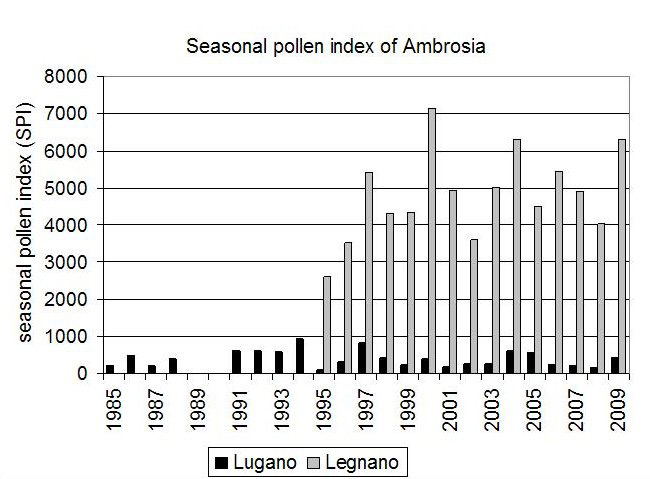
Figure 3
Seasonal pollen index (sum of daily concentrations from July-October) in Legnano (I) and Lugano (CH).
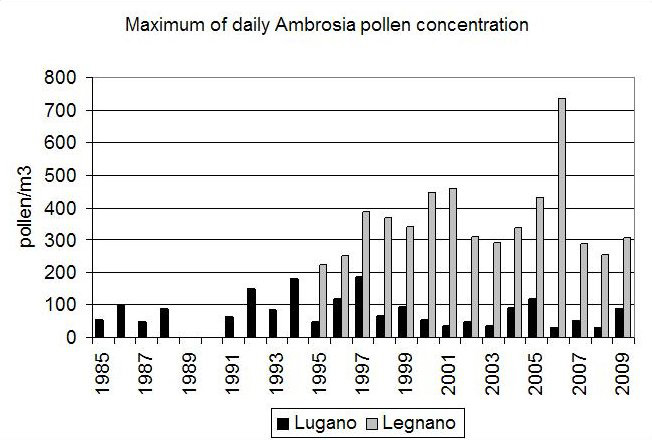
Figure 4
Maximum values of the daily pollen concentration in Legnano and Lugano.
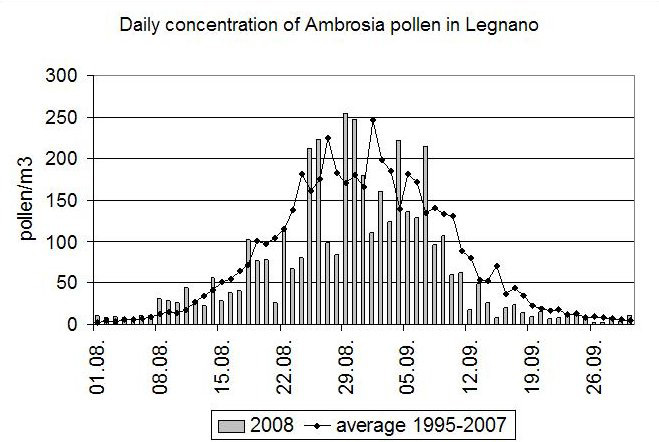
Figure 5
The daily concentration of Ambrosia pollen in Legnano in 2008 and the average daily concentration over the years 1995–2007.
Elderly people can also develop allergic sensitisation and allergic diseases, although the rate is lower than for younger people [30, 31]. For example in Switzerland, more than 4% still have pollinosis after their 60th birthday [31]. An impressive finding of our study was that sensitisation to Ambrosia pollen, to a much greater extent than for grass pollen, can appear after the age of fifty, thus demonstrating the allergenic potency of Ambrosia pollen. Among the over fifties, the incidence of grass pollen sensitisation stayed at the same level between 1999 and 2006, whereas the incidence of Ambrosia pollen sensitisation showed a marked increase of more than double that in 1999. Also, the number of Ambrosia sensitised patients aged more than sixty reached a percentage 1.6 times higher in 2006 than in 1999. In correlation with our results in table 2, a study in the Milan region on “new” respiratory allergens also showed that the age of onset for Ambrosia allergies is later than for other allergies related to “old” allergens such as grass pollen which have existed in the surroundings of Milan for centuries [8]. Interestingly, the new allergens (Ambrosia, Betula) seem to be responsible for the majority of the new respiratory allergies induced in previously mono-sensitised patients [32]. The time span of exposure to high concentrations of this new allergen is probably one of the important factors inducing allergies. The results from our study indicate that the consequences of high Ambrosia pollen concentrations are not immediately visible. The increase in Ambrosia sensitisation rates among patients continued over a time span of at least 15 years and, moreover, the increase in the incidence of respiratory symptoms started 5 years later than the increase in sensitisations.
The situation in the neighbouring canton of Ticino is quite different. According to the population based study SAPALDIA [22, 33], Ambrosia pollen is not an important cause of inhalant allergies in Switzerland. The sensitisation rates were low and did not change substantially between 1991 and 2002, although a new sensitisation to Ambrosia was observed in 1.4% of the study participants in Lugano and Geneva [22]. In 2002, in Lugano a total of 741 serum samples were tested for specific IgE to Ambrosia artemisiifolia (ImmunoCap w231, Phadia) and 6.9% of them tested positive [22]. If these Ambrosia positive results are calculated as a percentage of people sensitised to aeroallergens, the result is about 20% for Lugano, which comes close to the 24% of Ambrosia sensitised patients among the pollen sensitised patients in Legnano in 1989 at the beginning of our study. Another study comparing sensitisation rates in patients from Ticino showed an increase in sensitisation to Ambrosia from 10.14% in 1994 to 18.7% in 2009 [34].
The relatively low sensitisation rates in Lugano, compared with Legnano, can be explained by the much lower amount of Ambrosia pollen and also the lower number of days with a high pollen load (more than 11 or more pollen/m3).
An average SPI of 400 for Ambrosia pollen in Lugano still seems to be under the level above which a considerable continuous increase of sensitisation would start.
However, to prevent misinterpretation, we emphasise that it is important to start efficient containment measures as soon as the first plants appear, as the invasive spreading of Ambrosia makes later containment very difficult.
Obviously, the efforts of the authorities in the canton of Ticino have helped to contain the spread of Ambrosia. Our study results emphasise the importance of consistent measures and strategies to prevent a further spreading of Ambrosia.
| Table 1: Number of patients who attended the allergy unit of the hospital in Legnano for the first time. Sensitisation was tested by a skin prick test (SPT). The significance of the trends was calculated using the Mann-Kendall trend test: p <0.05*, p <0.01**, p <0.001***. | ||||
| Year | 1. visit total | Positive to pollen | Positive to Ambrosia | Percentage positive to Ambrosia who were positive to pollen (%) |
| * | ** | *** | *** | |
| 1989 | 1045 | 557 | 134 | 24.06 |
| 1990 | 746 | 396 | 151 | 38.13 |
| 1991 | 772 | 412 | 171 | 41.50 |
| 1992 | 838 | 450 | 166 | 36.89 |
| 1993 | 733 | 287 | 165 | 57.49 |
| 1994 | 759 | 348 | 197 | 56.61 |
| 1995 | 833 | 509 | 237 | 46.56 |
| 1996 | 897 | 511 | 300 | 58.71 |
| 1997 | 1253 | 702 | 407 | 57.98 |
| 1998 | 1310 | 734 | 372 | 50.68 |
| 1999 | 2059 | 1000 | 481 | 48.10 |
| 2000 | 1234 | 703 | 385 | 54.77 |
| 2001 | 1503 | 861 | 506 | 58.77 |
| 2002 | 1318 | 833 | 552 | 66.27 |
| 2003 | 971 | 609 | 402 | 66.01 |
| 2004 | 1412 | 898 | 633 | 70.49 |
| 2005 | 1115 | 721 | 501 | 69.49 |
| 2006 | 1163 | 904 | 507 | 56.08 |
| 2007 | 1026 | 620 | 426 | 68.70 |
| 2008 | 1008 | 605 | 433 | 71.57 |
| Table 2: Sensitisation to Ambrosia and grass pollen (SPT positive) in Legnano in the years 1999 and 2006 stratified into age groups. | |||||
| Ambrosia | Grass | ||||
| 1999 | Age of manifestation | Number of patients | % of total | Number of patients | % of total |
| <40 | 325 | 67.6 | 401 | 77.7 | |
| 40–50 | 90 | 18.7 | 67 | 13 | |
| 50–60 | 38 | 7.9 | 30 | 5.8 | |
| >60 | 28 | 5.8 | 18 | 3.5 | |
| Total | 481 | 516 | |||
| 2006 | <40 | 286 | 56.4 | 349 | 74.9 |
| 40–50 | 67 | 13.2 | 73 | 15.7 | |
| 50–60 | 106 | 20.9 | 25 | 5.4 | |
| >60 | 48 | 9.5 | 19 | 4.1 | |
| Total | 507 | 466 | |||
The exposure to high Ambrosia pollen concentrations (with an average SPI of 4800) has had serious consequences. During the last 4 years of the study, 70% of the pollen positive patients had been sensitised to Ambrosia and 90% of this group suffered from Ambrosia allergy. However, these consequences are not visible over the short term as the sensitisation rates have been constantly increasing over a period of more than 15 years, and the incidence of allergy is delayed during the first years.
Acknowledgements: The authors wish to thank Barbara Bramè (Ospedale Civile di Legnano) and Elisabetta Re (Ospedale Civile di Legnano) for collaboration in data acquisition of the clinical data, Giuseppe Cislaghi (ASL Milano 1) and Paola Colombo (ASL Milano 1) for collaboration in pollen counts, Andreas Pauling (MeteoSchweiz) for the statistical analysis, and Regula Gehrig (MeteoSchweiz) and Bernard Clot (MeteoSchweiz) for critically reading the manuscript and for their valuable comments.
1 Rybnicek O, Jäger S. Ambrosia (ragweed) in Europe. ACI International. 2001;13:60–6.
2 Járai-Komlódi M, Juhász M. Ambrosia Elatior (L.) in Hungary (1989–1990). Aerobiologia. 1993;9:75–8.
3 Dervaderics M, Fust G, Otos M. Differences in the sensitisation to ragweed and occurence of late summer allergic symptoms between natives and immigrant workers of the nuclear power plant of Hungary. Immunol Invest. 2002;31:29–40.
4 Dechamp C, Le Gal M, Deviller P. Prevalence of ragweed hayfever in the south and east of greater Lyon region in 1993. Allerg Immunol. 1995;27:320–5.
5 Thibaudon M, Lachasse C, Finet F. Ragweed in France and in the Rhône Alpes region. Eur Ann Allergy Clin Immunol. 2003;35:87–91.
6 Corsico R, Falagiani P, Ariano R. An epidemiological survey on the importance of some emerging pollens in Italy. J Invest Allergol Clin Immunol. 2000;10:155–61.
7 Bottero P, Venegoni E, Riccio G, Vignati G, Brivio M, Novi C, Ortolani C. Pollinosi da Ambrosia artemisiifolia in Provincia di Milano. Folia Allergol Immunol Clin. 1990;37(2):99–105.
8 Asero R. Birch and ragweed pollinosis north of Milan: a model to investigate the effects of exposure to “new” airborne allergens. Allergy. 2002;57:1063–6.
9 Asero R. The changing pattern of ragweed allergy in the area of Milan, Italy. Allergy. 2007;62:1097–9.
10 White J, Bernstein DI. Key pollen allergens in North America. Ann Allergy Asthma Immunol. 2003;91:425–35.
11 Jäger S. Ragweed (Ambrosia) sensitization rates correlate with the amount of inhaled airborne pollen. A 14 year study in Vienna, Austria. Aerobiologia. 2000;16:149–53.
12 Comtois P, Gagnon L. Concentration polliniques et fréquence des symptômes de pollinose: une méthode pour déterminer les seuils cliniques. Rev fr Allergol. 1988;28(4):279–86.
13 Bergmann K-C, Werchan D, Maurer M, Zuberbier. The threshold value of Ambrosia pollen inducing acute nasal reactions is very low. Allergo J. 2008;17:375–6.
14 Gehrig R, Pietragalla-Köhler B, Clot B, Herren T, Graber MJ, Hauser M et al. Luftpollengehalt in der Schweiz 2010. Zürich, MeteoSchweiz, 2011.
15 Pozzi P, Zanon P, Berra D, Chiodini E. Results of three years of aerobiological sampling in the atmosphere of Busto Arsizio. Aerobiologia. 1992;8:21–6.
16 Bonini M, Bottero P, Milani M. Prevalence and Clinical severity of Ragweed allergy in a Health care population in Magenta town: an epidemiological study on 1373 subjects. Allergy. 2009;64(Suppl. 90):S429.
17 Bonini M, Cislaghi G, Colombo P, Graziano E, Pellino P. Ambrosia a ovest di Milano. Eur J Aerobiol Environ Med. 2006;(Suppl. 1):S168–169.
18 Mandrioli P, Di Cecco M, Andina G. Ragweed pollen: the aeroallergen is spreading in Italy. Aerobiologia. 1998;14:13–20.
19 Peeters Annie G. Ambrosia sp. pollen in Switzerland. Aerobiologia. 2000;16:295–7.
20 Leuschner RM. Registrierte Luftpollen von Ambrosia L als Hinweis auf ein Vorkommen dieser Adventivpflanzen. Bauhinia. 1978;6:265–271.
21 Taramarcaz P, Lambelet B, Clot, B, Keimer C, Hauser C. Ragweed progression and its health risks: will Switzerland resist this invasion? Swiss Med Wkly. 2005;135:538–48.
22 Ackermann-Liebrich U, Schindler C, Frei P, Probst-Hensch NM, Imboden M, Gemperli A, et al. and the SAPALDIA team. Sensitization to Ambrosia in Switzerland: a public health threat on the wait. Swiss Med Wkly. 2009;139:70–5.
23 Köhler B, Gehrig R, Clot B, Ciotti V, Maspoli M. Ambrosialuftpollenmessungen in der Schweiz: Quantifizierung des Gefahrenpotentials und Indikator für die Ausbreitung der Pflanze. Nachrichtenbl Deut Pflanzenschutzd. 2006;58(11):299–303.
24 Köhler B, Gehrig R, Pauling A, Clot B. Which factors influence ragweed pollen concentration in Ticino? Eur Ann Allergy Clin Immunol. 2007;39:135.
25 Clot B, Schneiter D, Tercier P, Gehrig R, Annie G, Thibaudon M. Ambrosia pollen in Switzerland – produced locally or transported? Allerg Immunol. (Paris), 2002;34(4):126–8.
26 Mandrioli P, Comtois P, Dominguez Vilches E, Galan Soldevilla C, Isard S, Syzdek L. Sampling: Principles and Techniques. In: Mandrioli P, Comtois P, Levizzani V, editors. Methods in Aerobiology. Bologna: Pitagora Editrice;1998. p. 47–112.
27 Mann H. Nonparametric test against trends. Econometrica. 1945;13:245–59.
28 Kendall MG. Rank correlation methods 4th ed. London: Griffin;1970.
29 R Development Core Team. R: A language and environment for statistical computing [Internet]. Vienna: R Foundation for Statistical Computing. 2010. ISBN 3-900051-07-0;[cited 2010 Nov 22]. Available from: http://www.R-project.org.
30 Wöhrl S, Stingl G. Underestimation of allergies in elderly patients. Lancet. 2004;363:249.
31 Wüthrich B, Schnyder UW, Henauer SA, et al. Häufigkeit der Pollinosis in der Schweiz: Ergebnisse einer repräsentativen demoskopischen Umfrage unter Berücksichtigung anderer allergischer Erkrankungen. Schweiz Med Wochenschr. 1986;116:909–17.
32 Asero R. Analysis of new respiratory allergies in patients monosensitized to airborne allergens in the area North of Milan. J Invest Allergol Clin Immunol. 2004;14(3):208–13.
33 Wüthrich B. Prevalence of atopy and pollinosis in the adult population of Switzerland (SAPALDIA Study). Int Arch Allergy Immunol. 1995;106:149–56.
34 Colombo VM. Zum Sensibilisierungsspektrum von Pollenallergikern im Kanton Tessin: Eine prospektive Studie in Locarno und Lugano 2009. [dissertation]. Universität Zürich;2010.
Funding / potential competing interests: No financial support and no other potential conflict of interest relevant to this article were reported.